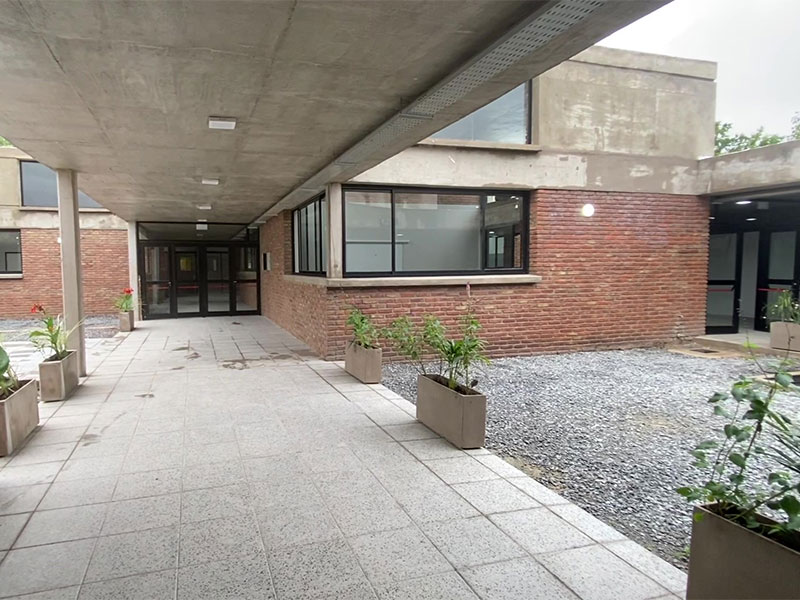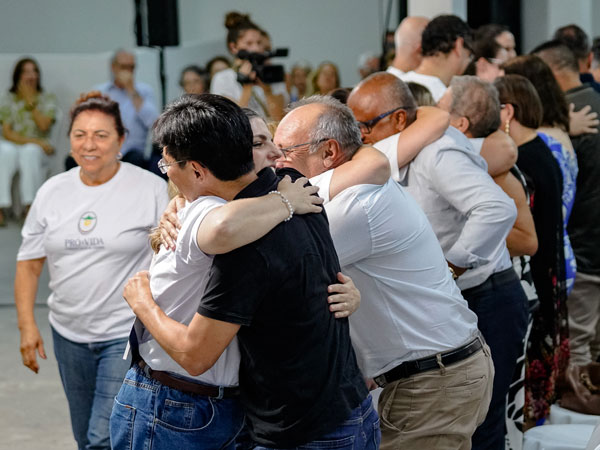Osiris, Isis, and Horus
Osiris, Isis, and Horus
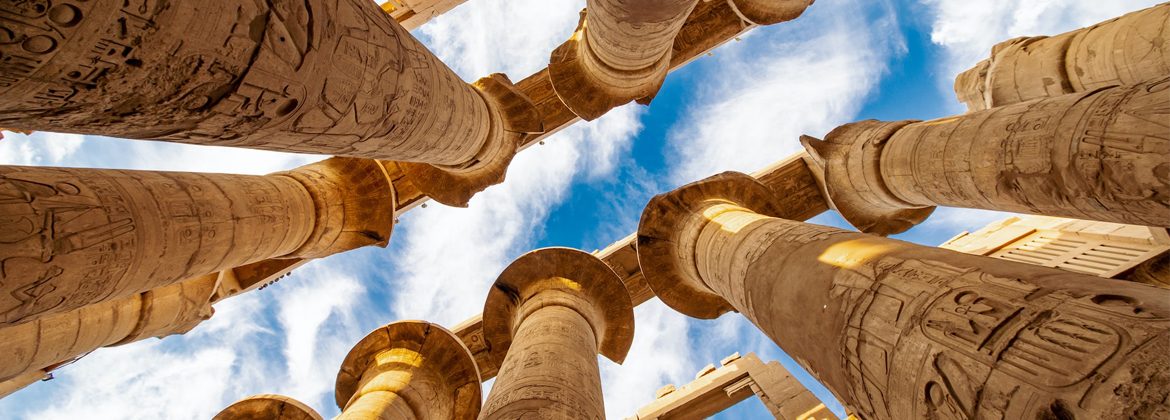
For the inhabitants of Ancient Egypt, belief was based on myths organized by popularity and importance. We’re talking about the original Egypt, the ancient one, not that which was invaded by the Persians, Macedonians, Romans, and finally conquered by the Muslims.
According to reports from some historians, there were thousands and thousands of worshiped deities. These divine beings had fundamental importance, powers over nature, and even influenced people’s lives. The beliefs were expressed in worship and rituals performed in temples and sanctuaries.
Among the many deities, there are the Egyptian triads, which consist of three deities from the same family. The first sacred triad of Egypt, the most popular, is composed of Osiris, Isis, and Horus.
Who were Osiris, Isis, and Horus?
It is said that Osiris, Isis, Seth, and Nephthys were siblings, children of Geb (earth) and Nut (sky).
Osiris was the god of agriculture and animals. The image is depicted in human form, with visible hands and head, and with half of his body emerging from a sarcophagus. In his hands, he held the royal scepters, the flail and the crook, and on his head, the white crown flanked by two feathers and adorned with ram’s horns. According to the myth, Osiris, as the king of Egypt, found his people immersed in barbarism and taught them the laws, agriculture, religion, and other blessings of civilization. He was the figure of the father, of goodness and wisdom. Later, he became known as the lord of the afterlife and the judge of the spirits that arrived there. According to legend, it was Osiris who judged the dead in the “Hall of Two Truths,” where the weighing of the heart took place.
Isis was originally depicted in human form, as a beautiful and elegant woman, showing a hieroglyph above her head in the shape of a throne or ladder, representing the path to follow, elevation. Later, she became the most important goddess of Ancient Egypt and, when she assumed power during the New Kingdom (around 1570 B.C.E.), she was depicted with the sun disc between the horns of a cow on her head, a symbol originally belonging to Hathor. In the beginning, she was the goddess of farming and harvests. She was seen as the embodiment of perfection in the form of a woman, wife, mother, priestess, with magical powers. She was the figure of motherhood and unconditional love, caring for all with protection and care.
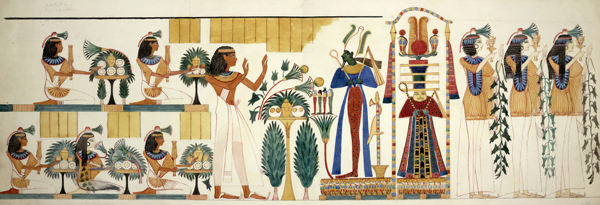
According to mythology, Isis was deeply in love with Osiris, her brother, and they joined with great love. As Osiris was a wonderful pharaoh and Isis a loyal and devoted companion, the couple was adored by their people. However, Osiris and Isis’ brother, Seth, was extremely envious and jealous of the happiness and power of the first, and he planned to kill him and take his place. Seth represents difficulty, evil, obstacles, everything that needs to be overcome.
There are various versions of Seth’s strategy to kill his brother. An intriguing version relates that Seth had a solid gold coffin made in homage to the gods to be displayed at a great feast. On the day of the feast, in front of all the guests, he proposed that anyone who entered the coffin and fit perfectly could take it as a gift.
Several people tried without success; however, “coincidentally”, the coffin had the exact measurements of Osiris, who, upon entering it, was very pleased with the perfect fit to his body. Seth immediately trapped him and threw him into the Nile River.
After Osiris’ disappearance, Seth claimed the throne, demanding everything that was his brother´s, including his companion, Isis, so that she became his queen.
The coffin floated down the Nile, reaching the Mediterranean Sea and eventually washed up on the shores of Lebanon, where it became lodged at the base of a tree. Over time, it solidified, and the tree became known as the Cedar of Lebanon.
Isis, distraught over the loss of her great love, grew wings and, in a desperate flight to find her beloved, managed to locate him. She recognized him in that lush tree and vigorously flapped her wings, attempting to resurrect her husband. She succeeded in bringing him back to life, but Seth was not content. This time, he decided to kill him with his own hands and, after dismembering him into 14 pieces, scattered them all over Egypt. Isis searched for and found 13 of the fragments. Once reassembled, the body was embalmed and mummified.
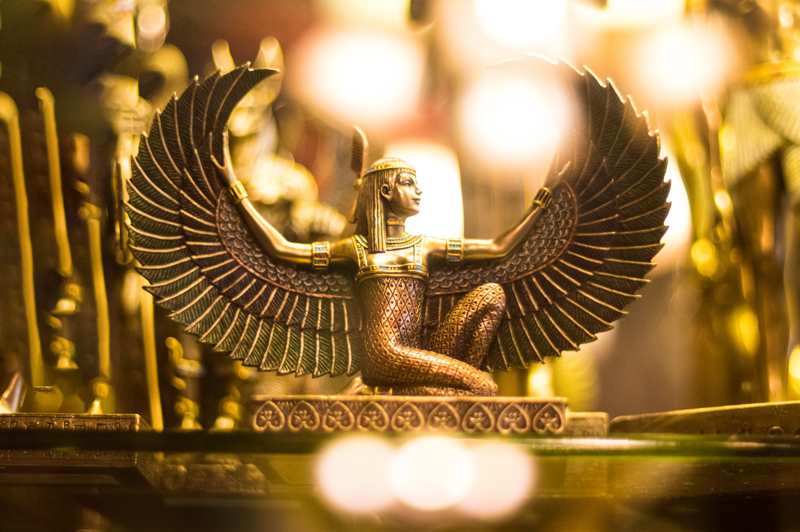
Isis then decided to immortalize her love and, with the help of the gods, bore their child alone: Horus, “The Warrior of Light.”
Horus was born from the source of life, from the love that gives birth. He was nurtured and raised with great care by his mother, who inspired him with the strength to fulfill his mission.
Horus appeared with a human body, a falcon’s head, and eyes representing the sun and the moon.
Soon, Horus became capable of many successes, including various battles with Seth, who occupied the throne. In one of these battles, he lost his left eye (the eye of the moon), which was replaced with a serpent amulet. In another version of the story, Thoth, god of wisdom and magic, reassembles the eye and puts it back. These battles represent the one who descends from a father no longer on Earth and a mother who taught him values and educated him with courage for the struggle, to claim and conquer what was rightfully his.
On one occasion, Horus triumphed but did not kill Seth, who continued to live, guarding the Barque of Ra. But Horus remained vigilant with his “all-seeing eye,” which became a symbol of great power, mastering what meant evil, selfishness, and envy. Horus assumed the throne and managed to free the people from the darkness caused by his uncle.
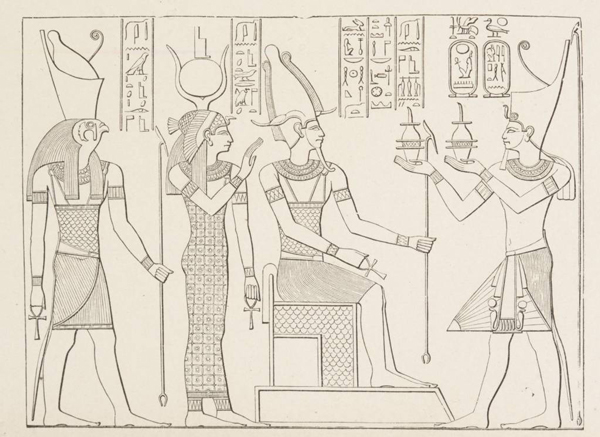
Osiris, Isis, and Horus were revered as great deities of ancient Egypt, representing strength and protection.
The primary center of worship for Osiris was located in Abydos, the capital of the 8th province of Upper Egypt, a place of pilgrimage. In this city, an annual festival dedicated to Osiris was celebrated, marking the god’s victory over his enemies, and a procession with his boat took place.
Isis became the protector of the young, children and the goddess of magic. Another interesting legend says that the Egyptians believed that the periodic flooding of the Nile River was produced by the tears of Isis, who wept for Osiris’s death. For this reason, the Egyptians celebrated the goddess’s festival when the waters of the Nile began to rise. Isis came to represent nature and, as the mother of all beings, was also depicted as a woman sitting, breastfeeding a child.
The main temple where Isis was worshiped is the Temple of Philae. It is a temple dedicated to love, located on a small island.
Horus was worshiped in the Temples of Kom Ombo and Edfu.
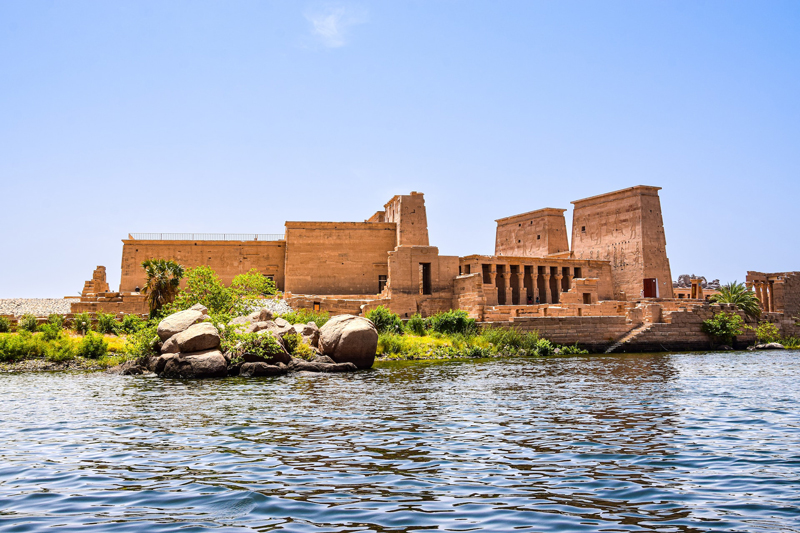
Much has been written about this famous and beloved triad, considered to be the first of Ancient Egypt, whose legend became known around 2400 B.C.E.
It is interesting to pay attention to some details of the mythology, such as good being imprisoned, drifting until it transforms into something representative. Also, the figure of love being rescued in pieces to perpetuate itself through the emergence of a new experience.
These references bear similarities to some ancient stories that portray the love that unites two beings, the courage and determination to overcome barriers, facing difficulties with resilience to fulfill a purpose, and ultimately, the triumph of good over evil.
References:
– Porto Editora – Osiris at Infopédia [online]. Porto: Porto Editora. [consult. 2022-04-12 01:32:31].
Available at https://www.infopedia.pt/$osiris
– Porto Editora – Egyptian mythology in Infopédia [online]. Porto: Porto Editora. [consult. 2022-04-12 01:30:00]. Available at https://www.infopedia.pt/$mitologia-egipcia




